
The Central Troy Historic District is an irregularly shaped, 96-acre (39 ha) area of downtown Troy, New York, United States. It has been described as "one of the most perfectly preserved 19th-century downtowns in the [country]" with nearly 700 properties in a variety of architectural styles from the early 19th to mid-20th centuries. These include most of Russell Sage College, one of two privately owned urban parks in New York, and two National Historic Landmarks. Visitors ranging from the Duke de la Rochefoucauld to Philip Johnson have praised aspects of it. Martin Scorsese used parts of downtown Troy as a stand-in for 19th-century Manhattan in The Age of Innocence.

There are 75 properties listed on the National Register of Historic Places in Albany, New York, United States. Six are additionally designated as National Historic Landmarks (NHLs), the most of any city in the state after New York City. Another 14 are historic districts, for which 20 of the listings are also contributing properties. Two properties, both buildings, that had been listed in the past but have since been demolished have been delisted; one building that is also no longer extant remains listed.
National Company Building is a historic department store building located at Rochester in Monroe County, New York. It was designed by J. Foster Warner in 1924 and is a five-story structure in the Classical Revival style. The Beaux-Arts decorated building is characterized by precise carved detailing.

Rockland County Courthouse and Dutch Gardens is a historic county courthouse, public garden, and national historic district located at New City in Rockland County, New York. The district has two contributing buildings, one contributing site, five contributing structures, and two contributing objects.

Three Squares Historic District is a national historic district located at Glens Falls, Warren County, New York. It includes 75 contributing buildings, one contributing site, and one contributing object. It encompasses Glens Falls historic and contemporary commercial center. The buildings generally consist of brick commercial, office, and institutional structures between two and five stories in height. Because of devastating fires in 1862 and 1902, the majority of the buildings were built between 1902 and 1930. Notable buildings include the Italianate style Cowles block (1865), Neoclassical style Rogers Building (1926-1927), Beaux-Arts style Empire Theater (1899), and Neoclassical style Glens Falls City Hall (1900).
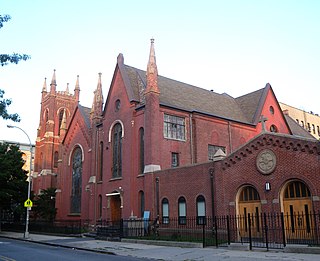
Clinton Hill Historic District is a national historic district in Clinton Hill, Brooklyn, in New York City. It consists of 1,063 largely residential contributing buildings built between the 1840s and 1930 in popular contemporary and revival styles. Buildings include freestanding mansions, row houses, and apartment buildings. The district includes the mansions of Clinton Avenue, built in the 1870s and 1880s. The most prominent of these are linked to Charles Pratt, who built a mansion for himself at 232 Clinton Avenue in 1874, the year his Charles Pratt & Company was acquired by Standard Oil, and one each as wedding presents for three of his four sons. These four mansions can be seen on Clinton Avenue between DeKalb and Willoughby. The rest of the historic district is noted for its prominent Italianate and Beaux-Arts rowhouses. The Clinton Hill South Historic District was listed in 1986.

The Hamilton Heights Historic District is a national historic district in Hamilton Heights, New York, New York. It consists of 192 contributing residential rowhouses, apartment buildings, and churches built between about 1886 and 1931. Most are three and four story brick rowhouses set behind raised stone terraces. The three churches within the district are St. Luke's, the Convent Avenue Baptist Church, and St. James Presbyterian Church. Architectural styles include Queen Anne, Romanesque, and Beaux-Arts.

West 147th–149th Streets Historic District is a national historic district in Harlem, New York, New York. It consists of 60 contributing buildings; 58 tenements, one school, and one stable built between 1894 and 1905. With the exception of the stable, all of the buildings are five or six stories tall, all with brick facades. Most have some form of terra cotta ornament and all have pressed metal cornices. The earlier buildings reflect the Romanesque Revival style, with ornamental inspiration drawn from Renaissance and French Beaux-Arts styles.

Park Place Historic District is a national historic district located at Niagara Falls in Niagara County, New York. It encompasses 89 contributing buildings, one contributing site, one contributing structure, and one contributing object. It is principally a residential district built up between 1885 and 1928. The dominant architectural styles are Italianate, Queen Anne, Colonial Revival, and Arts and Crafts. Within the district is a park with prominent obelisk, known as "The Cenotaph," and a notable stone fence. Located within the district is the separately listed James G. Marshall House. r It was listed on the National Register of Historic Places in 2010.
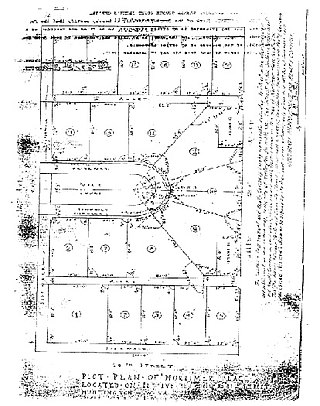
Mortimer Place Historic District is a national historic district located at Huntington, Cabell County, West Virginia. The district encompasses 21 contributing buildings and 1 contributing structure. The district is composed entirely of early 20th century residences, the majority of which are Colonial Revival and Tudor Revivalstyle. They were built between about 1915 and 1930, and feature sloping roofs, parapet walls, and wooden brackets and moldings. The residential development was designed and built by architect Richard Mortimer Bates, Jr. The Mortimer Place Historic District was listed on the National Register of Historic Places in 2001.

The River Street Historic District is a national historic district that is located in Wilkes-Barre, Pennsylvania.
This is a timeline and chronology of the history of Brooklyn, New York. Brooklyn is the most populous of New York City's boroughs, and was settled in 1646.
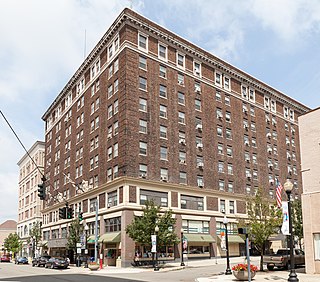
Jamestown Downtown Historic District is a national historic district located at Jamestown in Chautauqua County, New York. The district encompasses 103 contributing buildings in the central business district of Jamestown. The district developed between about 1873 and 1956, and includes buildings in a variety of architectural styles including Italianate, Gothic Revival, Second Empire, Romanesque Revival, Classical Revival, Renaissance Revival, and Art Deco. Located in the district is the separately listed Wellman Building. Other notable buildings include the Arcade Building (1898), Odd Fellows Lodge (1914), Bank of Jamestown, Hotel Samuels (1910), Hotel Jamestown (1924), Chautauqua School of Nursing (1911), Jamestown Telephone Company (1930), Maddox Building (1933), First National Bank (1953), Pennsylvania Gas Company building, Chautauqua National Bank (1956), Palace Theatre, Allen's Opera House, and the former Broadhead Worsted Mills.
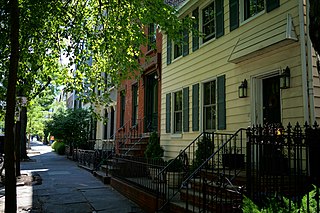
Wallabout Historic District is a national historic district located in the Wallabout neighborhood of Brooklyn, Kings County, New York. The district encompasses 203 contributing buildings in a mixed residential and commercial / industrial section of Brooklyn. The district features noteworthy examples of Greek Revival, Gothic Revival, Italianate, Second Empire, Queen Anne, Beaux-Arts, and Colonial Revival style architecture. It largely developed between about 1830 and 1880, with some later development. It includes vernacular wood houses, masonry single-family rowhouses in brick and brownstone, and multi-family tenements and flat houses.

Crown Heights North Historic District is a national historic district located in the Crown Heights neighborhood of Brooklyn, Kings County, New York. The district encompasses 1,019 contributing buildings in a predominantly residential section of Brooklyn. The district features noteworthy examples of Greek Revival, Gothic Revival, Italianate, Second Empire, Queen Anne, Romanesque Revival, Renaissance Revival, Beaux-Arts, and Colonial Revival style architecture. It largely developed between about 1853 and 1942, and consists of densely constructed rowhouses, townhouses, two-family houses, semi-attached houses, freestanding houses, flats, apartment buildings, and institutional and commercial buildings.
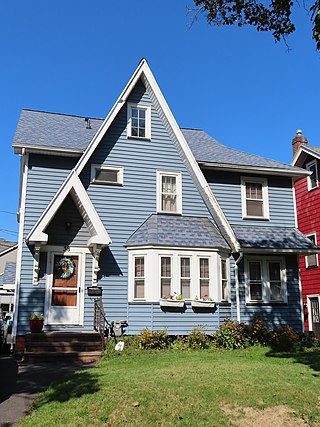
Arvine Heights Historic District is a national historic district located at Rochester, Monroe County, New York. The district encompasses 61 contributing buildings in an exclusively residential section of Rochester. The district developed between about 1920 and 1942, and includes residential buildings in a variety of architectural styles including Colonial Revival, Tudor Revival, and Bungalow / American Craftsman. The dwellings reflect modest designs directed toward a middle-class clientele in a newly developing area of Rochester's Nineteenth Ward.

Chili–West Historic District is a national historic district located at Rochester, Monroe County, New York. The district encompasses 508 contributing buildings in a predominantly residential section of Rochester. The district developed between about 1874 and 1935, and includes buildings in a variety of architectural styles including Queen Anne, Colonial Revival, Gothic Revival, and Tudor Revival, Mission Revival, and Bungalow / American Craftsman. The dwellings reflect designs directed toward a middle-class and working class clientele in a newly developing area of Rochester's Nineteenth Ward. Located in the district is the former St. Augustine Roman Catholic Church complex.

Holley Village Historic District is a national historic district located at Holley, Orleans County, New York. The district encompasses 40 contributing buildings, 1 contributing site, and 1 contributing object in the central business district of the village of Holley. The district developed between about 1822 and 1952, and includes buildings in a variety of architectural styles including Greek Revival, Italianate, Queen Anne, Beaux Arts, and Late Gothic Revival. Notable contributing resources include the Public Square and Salisbury Fountain (1914), First Presbyterian Church, White-Alis Building, Village Building, Rutland Block/Lockwood Building/Community Library (1896), Odd Fellows Hall (1890), Downs Residence, St. Mary's Roman Catholic Church (1904-1905), Downs Hotel/Hotel Holley designed by Andrew Jackson Warner, Village Building and Holley Standard, First Methodist Episcopal Church (1868-1869), and the Holley High School (1930-1931).

Fort Plain Historic District is a national historic district located at Fort Plain in Montgomery County, New York. When first listed it encompassed 536 contributing buildings, 2 contributing sites, 1 contributing structure, and 2 contributing objects in the central business district and surrounding residential sections of the village of Fort Plain. It developed between about 1786 and 1938, and included notable examples of Federal, Greek Revival, Gothic Revival, Italianate, Second Empire, Queen Anne, and Beaux-Arts style architecture. Located in the district is the separately listed United States Post Office. Other notable contributing resources include the Red Mill, Firemen's Home, Methodist Church (1880), Baptist Church (1896), Reformed Church (1887), high school (1915), Nellis Memorial Chapel, Watkins Block (1936), Montgomery Hall, Wick Block, Village Hall, and Fort Plain Cemetery.

Historic Hotels of America is a program of the National Trust for Historic Preservation that was founded in 1989 with 32 charter members; the program accepts nominations and identifies hotels that have maintained their authenticity, sense of place, and architectural integrity. In 2015, the program included over 260 members in 44 states, including the District of Columbia, Puerto Rico, and the U.S. Virgin Islands. In 2022, the program includes 273 hotels. This article lists current and former member hotels.






















